Common Injuries of the Ankle
- Fracture of the Ankle/Lower Leg
- Fibula Fracture: most common seen in sport activities
- Talus Fracture: least common but can be mistaken as ankle sprains
- Tibia Fracture: can be very serious and debilitating due to its status as the primary weight bearing bone
- Fractures
- MOI: Direct force against bone or indirect abuse such as twisting motion
- S&S
- High levels of pain
- Swelling and discoloration
- Obvious deformity
- Inability to bear weight
- Decrease strength and range of motion
- Treatment:
- Splint
- Immobilize
- Non weight bear (NWB)
- Surgical interventions
- Stress Fractures
- Stress fx in the tibia and fibula are significant in their occurrence rates in athletics
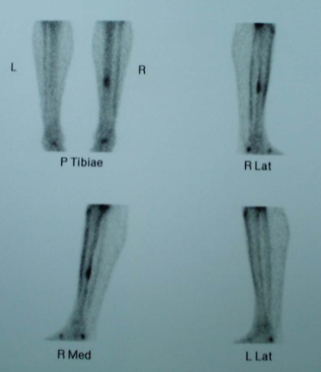
- S&S
- Pain that has developed gradually and increased in severity
- Pain likely to be worse after activity rather than during motion
- Pain localized to one specific point
- Treatment
- Bone Scan may be necessary
- Remove from sport, NWB or PWB for 4-6 weeks
- Cross training regimen
- Immobilization
- Insoles, new shoes, orthotics to correct biomechanics
- Diet
- Ankle Dislocation
- MOI: twisting motion during full weight bearing, ankle sprain mechanism
- The talus will tear the supporting ligaments and often fractures either or both of the malleoli because the talar dome is forcibly removed from its normal position
- Sometimes a dislocation can include a tibia/fibula fx
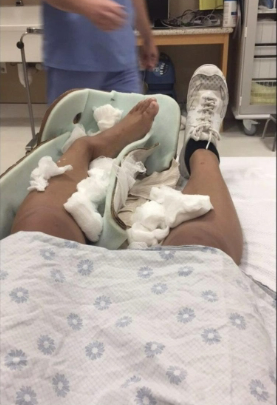
- S&S
- Extreme pain
- Obvious deformity
- Swelling and discoloration
- Loss of ROM and strength
- Treatment
- Immediate splinting and referral
- Surgical intervention
- Crutches and immobilization 4-6 weeks with RTP 4-6 months
- Shin Splints
- Also called Medial Tibial Stress Syndrome
- MOI: occurs as a result of a sudden increase in duration of intensity of training
- Location is commonly in the anterior compartment of the lower leg
- Can include tibialis anterior strain, microtears in the muscle, microfractures in the tibia or even stress fx
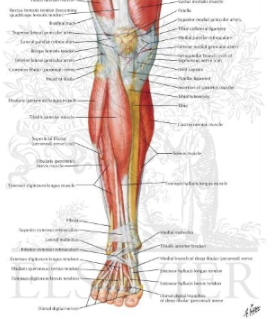
- S&S
- Pain increasing with running and dorsiflexion
- No obvious traumatic mechanism
- Treatment
- Cold modalities: ice massage, cold whirlpool
- Massage
- Stretching and strengthening
- Compression
- Insoles or orthotics
- Compartment Syndrome
- Anterior muscle compartment is contained within layers of fascial tissue that help maintain position and muscle shape
- Compartment Syndrome may occur either through acute trauma or chronic overuse
- MOI: increase in fluid pressure within the facial tissue that then compresses the muscles, nerves and blood vessels
- The compression causes a loss of oxygen to the muscle which can result in tissue death and serious complication
- Chronic is typically found in runners and causes pain and muscle ischemia during activity and then subsides once the activity is ceased.
- Many individuals with compartment syndrome complain of foot numbness or tingling during activity caused by increased tissue pressure
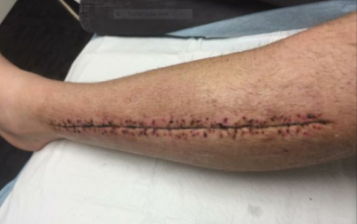
- S&S
- Pain that increases with activity
- Numbness/tingling in foot
- Foot drop resulting from neurovascular damage in the lower leg
- Pain subsides during rest
- May occur bilaterally
- Treatment
- Refer to physician
- Surgical intervention
- Cross training
- Ankle Sprains
- One of the most common injury in athletics
- Three ligament structured are associated with the ankle joint
- Anterior Talofibular Ligament (ATF) -> Inversion Ankle Sprain
- Lateral Ankle Sprain
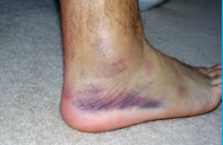
- MOI: when ankle is forcibly moved into inversion and plantarflexion
- ATF: first to be injured because it is the weakest of the three ligaments due to its anterior position
- S&S
- Swelling, discoloration, pain
- Joint laxity
- Decreased ROM
- Decreased ability to WB
- Deltoid Ligament -> Eversion Ankle Sprain
- MOI: Excessive eversion and dorsiflexion
- Medial Ankle Sprain
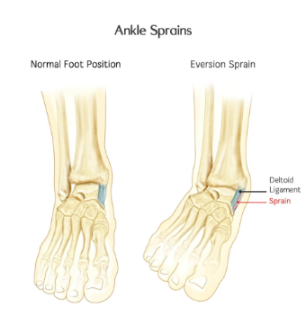
- Occurs in 5% of all ankle sprains
- S&S
- Pain and discomfort
- Decreased ROM
- Decreased ability to WB
- Swelling and discoloration
- Tibiofibular Ligament (TFL)-> High Ankle Sprain
- MOI: forced dorsiflexion and rotation of the ankle at the talar dome that causes separation of the tibia and fibula
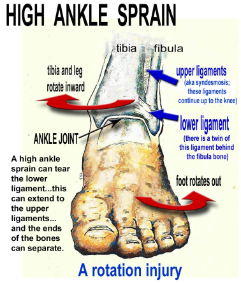
- S&S
- Pain in high ankle/lower leg
- Pain with WB
- Slight to no swelling
- Decreased ROM
- Decreased strength
- Treatment for Ankle Sprains
- RICE
- Immobilization if necessary
- Rehab: Ankle pumps, ABCs (ROM is key)
- Strengthening Exercises
- Proprioception Neuromuscular Control
- Cold whirlpool
- Horse shoe pad
- Achilles Rupture
- Most commonly seen in adults older than 30 years who have lost general flexibility or individuals starting new training program after being sedentary for an extended period of time
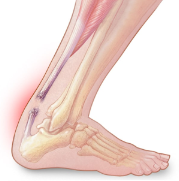
- MOI: pushing off or inversion/plantarflexion (ankle sprain)
- S&S
- Disruption of the structure and rolling of the tendon upward toward the muscle belly
- Pain (intense at the onset of the injury)
- Treatment
- Surgical intervention
- 1 year long recovery







